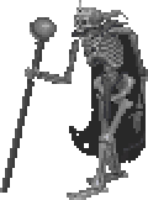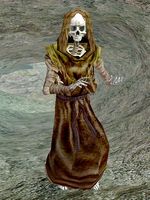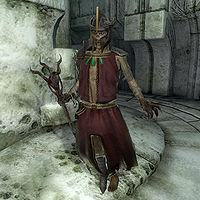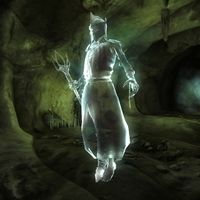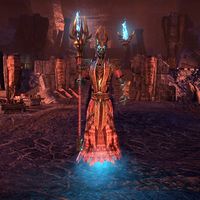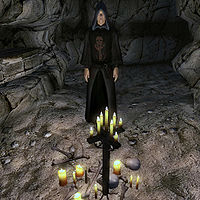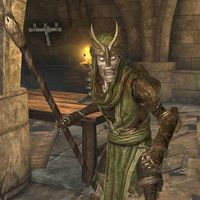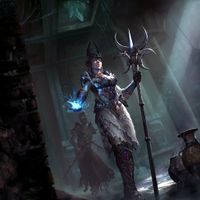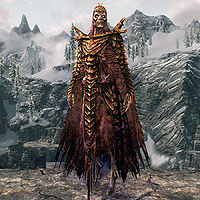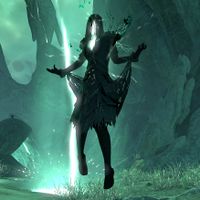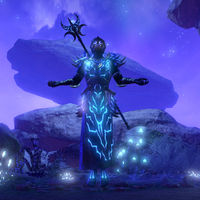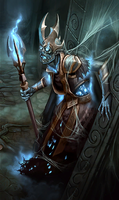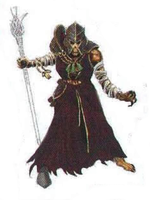Lore:Lich
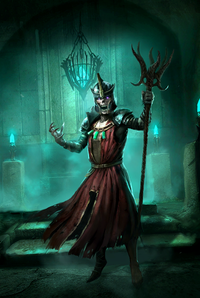
Liches are undead necromancers which have embraced the power of lichdom, the most sophisticated form of Undeath. It is commonly done by transferring their soul into an object called a 'Phylactery'. They are typically selfish and power-hungry, destroying all in their search for souls to repair the Phylactery. Extremely intelligent and powerful, a commonly held myth is that if the Phylactery is destroyed the lich will also be destroyed; however, the Phylactery simply serves as a vessel during the transference, and once the necromancer has transcended the Phylactery is of no consequence.[1]
Though destroying the Phylactery will not automatically destroy a lich,[1] a number of liches have used their Phylacteries as an anchor to allow them to revive after being slain.[2][3][4][5][6][7] In such cases the destruction of the Phylactery is required in order to permanently slay the lich itself, with the Phylactery being described as an object to which the lich is bound due to their unique nature, and a tether along which the lich can return to the world, thus making their death no longer a concern. Phylacteries have also been likened to a spiritual focus, like an arcane vessel or container that contains larger portions of one's soul, thus making them powerful but dangerous tools.[4] The form a Phylactery takes can vary, and there have been cases of liches using their towers,[5][2] or even an entire realm they created themselves as a Phylactery, to anchor themselves and revive after death.[4][7][6][3]In some cases, permanently destroying the lich might require shattering its otherwise imprevious Phylactery with tools imbued with the lich's own power, and physically killing it before it can recreate a Phylactery while in its "hemomorphic spiritual form".[2][5] In others one might have to shatter multiple Phylacteries and vanquish the slivers of the lich's soul guarding them in order to destroy the lich itself.[7][6][3][4] There have been liches that achieved such a form of immortality that they could not be permanently slain and had to be sealed away through the use of a sealing ritual and an Elder Scroll that would bind them to the one future where they failed to escape.[8]
There have been cases of slain liches whose souls were extracted through rites of cleansing possessing their would be killers and consuming their spirits from within, instead, merging the lich and its vanquisher into a composite being. Such was the case for lich Erandur-Vangaril, a lich formed when the spirit of the former Mages Guild wizard Vangaril, was consumed from within by the spirit of his former friend whom he had slain, the lich Erandur.[9][10]
Only Necromancers with the utmost mastery of the Dark Arts can turn inward in their studies, attempting to manipulate their very own soul. Lichdom requires divesting one's soul and mortal form, removing the boundaries, the checks, placed on the mortal will by it. By accomplishing this feat, the Necromancer gains access to a virtually limitless magical horizon. Of course, the process exacts a heavy toll, as traveling through the Phylactery can tear a lich's psyche apart, resulting in madness. Long separation from one's soul can lead to apathy and megalomania as well, even if the Necromancer succeeds. In almost all cases, lichdom becomes a curse in very short order for those who succeed.[4]
According to one lich's account, becoming a lich greatly increased his magical power, making it possible for him to use spells the magnitude of which even those who considered themselves magically powerful had no idea of. The lich described Destruction magic as having become as natural to him as breathing had been, claimed he'd subsequently unravel the mysteries of other schools such as Illusion and Alteration, and even described magic as now being akin to a "friendly pet" to him. However, this increased power came at a heavy price. The lich's sanity gradually deteriorated, starting with bouts of megalomania where he'd liken himself to the gods, and gradually progressing to lapses in concentration, and finally struggling to remember his own name or even what he was. Other liches that the lich initially sought to partner with were likewise described as "raving mad", and he was forced to slay them. In the end the lich slew his own coven and started seeking a way to reverse his new state of being, to no avail.[11][12][13]
According to some accounts by liches, most basic mortal needs, and sensations such as pain, become but distant memories to them.[13][14]. Liches are said to be capable of devouring souls.[15][16] Powerful liches can attempt to exert mental control over not just undead thralls, but also other liches, in order to repel them or to claim command over them. Even if the targeted lich resists, effects can range from difficulty focusing to feeling as if one has been struck blind and deaf.[4] In combat, some liches have been known to possess abilities such as being able to see the invisible, requiring mithril or better quality weapons to harm, and regenerating from injury.[16][17][18]
Lichdom is very hard to accomplish, taking large amounts of time and effort.[1] One method involves using the souls of innocents to achieve lichdom, the higher amounts of pain from the unwilling victims produce a purer and stronger form of lich.[19] This method also requires a powerful magical relic, as it acts as a casting focus for 'Urelu's Loathsome Coercion', the spell used to take the souls from the victims; the higher a relic's power is, the more painful the soul tearing will be.[19] Due to the amount of effort to accomplish lichdom, it's very rare for a traveler to encounter one, as most will stay in tombs studying obsessively.[20] Liches have been known to disguise their true form using Illusion magic to lower the defenses of unwary travelers.[21][4]
Necromancy can also be used to transform people into a lich even if they are not practicing necromancers in life. Notable examples of this include Prince Naemon and the Spinner Indinael, whose corpses were posthumously transformed into liches.[22][23]
Mannimarco is described in a poem as the "world's first of the undying liches",[24] though its unclear if he was indeed the first to achieve the state of lichdom. After his ascension, he was known to reveal the secrets of lichdom to his followers through direct communion so that they may serve him in undeath as Worm Eremites.[1] One lich, the powerful dro-m'Athra Arum-Khal, managed to create an entire realm of existence to use as his Phylactery.[3]
Variants[edit]
A weaker variant of lich is the Nether Lich, which can appear spectral in comparison to a normal lich.[25] Outcasts are even weaker again, being closer to a spellcasting wight than a true lich.[26]
Archliches are a more powerful form of lich.[27][28] There is a type of lich called the Demi-Lich; the only known example was named Zaraphus.[29]
Dragon Priests are a specific type of Nordic lich.[30] Unlike the methods necromancers use, these liches are sustained from the transfer of life energy after death. Draugr in the Nordic tombs transfer their life force into the body of their master, perpetuating the "life" of the priest and giving them a powerful form of undeath akin to lichdom.[31] Ancient Deathpriests are another type of Nordic lich, of which much less is known.[32]
Some Reachmen clans may look to darker avenues to appease Namira, such as human sacrifices. Those that undergo such practices may seek to twist and abuse Namira's gifts to gain power, which when wielded, can cause great calamities.[33] This brings out dark corruptions known as "voidstuff", which can empower a clan's witch, turning them to Voidmothers, also known as Void Liches, which can consume the souls of their victims.[34] They are not traditional liches, and are considered a type of Shade, dark, hateful, and hungry spirits that have been twisted by being in contact with Namira's energy, such as that of the Dark Heart.[35]
Khajiit that become liches can also become Drom-m'Athra, giving rise to Dro-m'Athra liches such as Dark Adept Arum-Khal, which are said to be even more dangerous than normal liches.[4][3]
Notable Liches[edit]
Gallery[edit]
An undead Dragon Priest (Skyrim)
A dro-m'Athra lich (ESO)
Ayleid lich from Fallout Shelter Online
Deslandra as a lich
(Betrayal of the Second Era)
Notes[edit]
- Based on his research of necromancy and Ayleid culture, Master Sadren Sarethi theorized that Wispmothers are a cult of powerful sorceresses who achieved a unique state of lichdom developed by a now-forgotten First Era culture. Many alternate theories as to their origin have also been presented, however.[36]
- Some liches have claimed they'd eventually return despite having no known Phylacteries that they were using as a means of resurrection.[14]
- The lich Celemaril, who could not be killed and needed to be sealed away via the use of an Elder Scroll, was noted to have a symbiotic relationship with the Abyss Oblivion realm, but its unclear if that bond had any effect on his immortality.[8][37]
See Also[edit]
- For game-specific information, see the Arena, Daggerfall, Morrowind, Tribunal, Oblivion, Oblivion Mobile, SkyrimCC, Elder Scrolls Online, Blades, and Castles articles.
References[edit]
- ^ a b c d The Path of Transcendence — Celedaen
- ^ a b c Events of Blood, Books, and Steel in ESO
- ^ a b c d e The Moonlight Blade quest in ESO
- ^ a b c d e f g h Vastarie's dialogue in ESO
- ^ a b c Squire Rayan in ESO
- ^ a b c Shando-ri's dialogue in ESO
- ^ a b c Mazza-Mirri's dialogue in ESO
- ^ a b Shulkunaak's dialogue in Blades
- ^ Events ofLich of Lost Boy Cavern in Oblivion
- ^ Erandur-Vangaril's appearance in Oblivion
- ^ A Wound In Time quest in Oblivion Remastered
- ^ Saving Time Itself quest in Oblivion Remastered
- ^ a b Corelian's diary — Corelian
- ^ a b Zelvraak the Unbreathing's dialogue in ESO
- ^ Celemaril's dialogue in Blades
- ^ a b J'skar's dialogue in Oblivion
- ^ Lich abilities in Arena
- ^ Lich abilities in Daggerfall
- ^ a b Ascendancy: Pathway to Lichdom — Gullveig the Ascendant
- ^ Unhallowed Legions — Phrastus of Elinhir
- ^ Civility and Etiquette V. 5: Undead — Coristir
- ^ Circumstances surrounding the Shade of Naemon's appearance in ESO
- ^ Events of Fulfilling One's Fate in ESO
- ^ Mannimarco, King of Worms — Horicles
- ^ Nether Liches in Oblivion
- ^ Outcasts in Blades
- ^ Archlich in Blades
- ^ Nether Archlich in Castles
- ^ Corim Ashlen's dialogue in Arena
- ^ Valdar's dialogue in Skyrim
- ^ Amongst the Draugr — Bernadette Bantien, College of Winterhold
- ^ Ancient Deathpriests in Skyrim
- ^ Gwenyfe's dialogue on Voidmother Elgroalif related quests in ESO
- ^ Rites Matron's dialogue in ESO
- ^ Count Verandis Ravenwatch's dialogue in ESO
- ^ The Wispmother — Mathias Etienne
- ^ Abyssal Altar description in Blades
Note: The following references are considered to be unofficial sources. They are included to round off this article and may not be authoritative or conclusive.
| ||||||||||||||||||||



